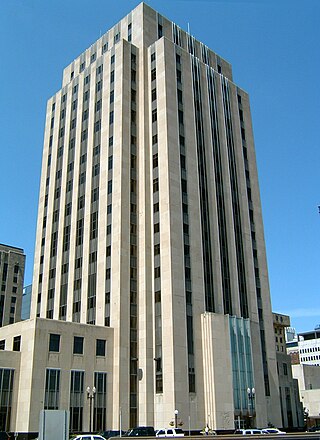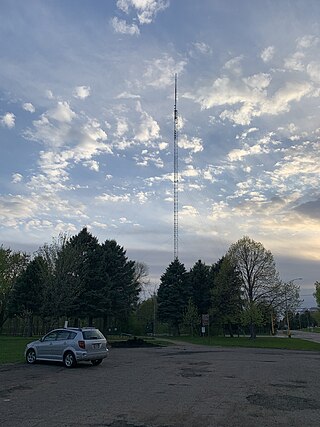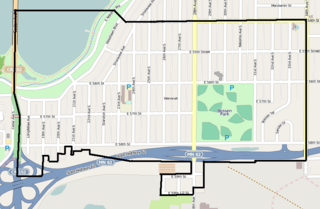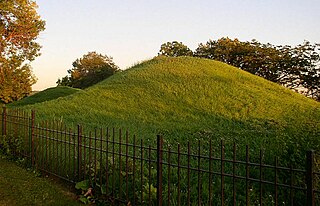Related Research Articles

Ramsey County is a county located in the U.S. state of Minnesota. As of the 2020 census, the population was 552,352, making it the second-most populous county in Minnesota. Its county seat and largest city is Saint Paul, the state capital and the twin city of Minneapolis. The county was founded in 1849 and is named for Alexander Ramsey, the first governor of the Minnesota Territory.

The Minnesota House of Representatives is the lower house of the legislature of the U.S. state of Minnesota. It has 134 members, twice as many as the Minnesota Senate. Floor sessions are held in the north wing of the State Capitol in Saint Paul. Member and staff offices, as well as most committee hearings, are in the nearby State Office Building.

The Minnesota Senate is the upper house of the Legislature of the U.S. state of Minnesota. At 67 members, half as many as the Minnesota House of Representatives, it is the largest upper house of any U.S. state legislature. Floor sessions are held in the west wing of the State Capitol in Saint Paul. Committee hearings, as well as offices for senators and staff, are located north of the State Capitol in the Minnesota Senate Building. Each member of the Minnesota Senate represents approximately 80,000 constituents.

The Minneapolis-Saint Paul Metropolitan Airports Commission (MAC) is the owner and operator of Minneapolis-Saint Paul International Airport in Minnesota as well as six other reliever airports in the Twin Cities region, which primarily provide service to private individuals and businesses, but also have regional transportation service.

KBEM-FM is a Minneapolis, Minnesota public radio station broadcasting a jazz format. The station is operated by the Minneapolis public school system and has been partnering since 1989 with the Minnesota Department of Transportation (Mn/DOT), providing traffic congestion reports for commuters in the Minneapolis-St. Paul metropolitan area. KBEM also broadcasts live headliner performances from the Twin Cities Jazz Festival each June. KBEM is a member of Minnesota's AMPERS network.

Area code 651 is the telephone numbering plan code for Saint Paul, Minnesota, and the eastern suburbs of the Twin Cities. A dogleg portion also extends to the southeast along the Mississippi River to include cities such as Hastings. The region was the fifth area code created in the state in 1998, when it was carved out of area code 612.

Midway Stadium was the name of two different minor league baseball parks in Saint Paul, Minnesota, United States, both now demolished. The name derived from the location of the stadium in St. Paul's Midway area, so named because it is roughly halfway between the downtowns of Minneapolis and Saint Paul.

The Twin Cities Assembly Plant is a former Ford Motor Company manufacturing facility in Saint Paul, Minnesota, United States, that operated from 1925 to 2011. In 1912, Ford's first assembly and sales activities in Minnesota began in a former warehouse in Minneapolis. By 1925, Ford had relocated its local operations to the bluffs above the Mississippi River in the Highland Park neighborhood of Saint Paul. In 2006, Ford officials announced plans to close the factory, though it operated for three years past the 2008 closure date initially announced. At the time of its closure, it was the oldest Ford plant in continuous operation. The plant's final truck was completed on December 16, 2011. All of the facility's buildings were demolished and the site underwent extensive environment remediation in the late 2010s, paid for by the Ford company. Following a multi-year planning and community engagement process, the site was sold to the Ryan Companies, who began redevelopment of the site in 2020 as Highland Bridge, a 122-acre residential and commercial district.
The Prom Ballroom was a dance hall in Saint Paul, Minnesota, United States, which opened in 1941 with a performance by Glenn Miller. The club played a diverse array of acts, ranging from rock to polka and jazz, and included acts like Count Basie and Lawrence Welk. The house orchestra was called the Jules Herman Orchestra. The infamous and ill-fated "Winter Dance Party" was the attraction on January 28, 1959.
The Franciscan Brothers of Peace is a Roman Catholic, Franciscan association for men. It was founded in 1982 by Michael Gaworski. It was recognized as a public association of the faithful in 1994 by Archbishop Roach. The mother house of the order is in Saint Paul, Minnesota, United States, in the Roman Catholic Archdiocese of Saint Paul and Minneapolis. As of January 2020 they were 11 brothers. In keeping with their anti-abortion charism, the Brothers advocate for the unborn, the handicapped, the elderly and the poor.
The U of M Transitway is a busway that runs between the University of Minnesota's Minneapolis and St. Paul campuses. Use of the roadway is limited to buses, bicycles, and emergency vehicles. The University of Minnesota runs zero-fare buses along the busway connecting the two campuses, primarily the Campus Connector but also shuttles to and from the St. Paul campus for football games. A bicycle trail runs alongside the transitway for most of its distance. Between the endpoints, there are only two intersections with stoplights controlling busway traffic at Energy Park Drive and Como Avenue. The stoplights are designed to normally give the buses priority, so it is possible for many buses to run the length of the transitway without stopping.

Wenonah is a neighborhood on the southeast side of Minneapolis, Minnesota. Its boundaries are 54th Street to the north, 34th Avenue to the east, the Minneapolis-Saint Paul International Airport to the south, and Cedar Avenue to the west. The neighborhood contains a portion of Lake Nokomis. It shares a neighborhood organization with the Keewaydin, Minnehaha, and Morris Park neighborhoods, which are collectively referred to as Nokomis East and are served by the Nokomis East Neighborhood Association (NENA).

The Minneapolis Fire Department provides fire protection and first responder emergency medical services to the city of Minneapolis, Minnesota.

Dayton's Bluff is a neighborhood located on the east side of the Mississippi River in the southeast part of the city of Saint Paul, Minnesota which has a large residential district on the plateau extending backward from its top. The name of the bluff commemorates Lyman Dayton, for whom a city in Hennepin County was also named. On the edge of the southern and highest part of Dayton's Bluff, in Indian Mounds Park, is a series of seven large aboriginal mounds, 4 to 18 feet high, that overlook the river and the central part of the city.
The Finance & Commerce is a daily newspaper devoted exclusively to business in the Twin Cities and Rochester, Minnesota.

Frogtown is a neighborhood in Saint Paul in the U.S. state of Minnesota. Built around University Avenue, the Thomas-Dale neighborhood is colloquially known as Frogtown. Historically, Frogtown was a subsection of the current Thomas-Dale neighborhood. It is bordered by University Avenue on the south, the Burlington Northern Railroad tracks to the north, Lexington Parkway on the west and Rice Street on the east.

Mayday Books is a volunteer-run, non-profit collective bookstore in Minneapolis, Minnesota. Established in 1975, its organizational mission is to provide leftist political books and magazines and a space for political organizing for the Minneapolis/Saint Paul metropolitan area. Mayday Books carries a selection of new and used political books, magazines, zines, T-shirts, postcards, and select CDs and DVDs.
WAJC 88.1 FM is a radio station licensed to Newport, Minnesota, and serving the south central Minneapolis–Saint Paul metropolitan area. The station broadcasts a Contemporary Christian music format and is owned by the Maranatha Assembly of God Church. Its transmitter is located in a park near Coates.
The House of Hope Presbyterian Church in Saint Paul, Minnesota was founded in 1907, by the merger of two churches that were founded in 1849 and 1855.

Blue Door Pub is a chain of restaurants in Minneapolis and Saint Paul, Minnesota, that has 5 locations, including one at the Minneapolis–Saint Paul International Airport. It is known for the Blucy, a variant of the Jucy Lucy. The Blue Door has been featured on Food Paradise, Man v. Food, and Diners, Drive-Ins and Dives.
References
- ↑ Millett, Larry. Metropolitan Opera House, Lost Twin Cities, Minnesota Historical Society Press, 1992. Pg 122, 159, 260. Retrieved March 25, 2020.
Coordinates: 44°56′52″N93°5′32″W / 44.94778°N 93.09222°W